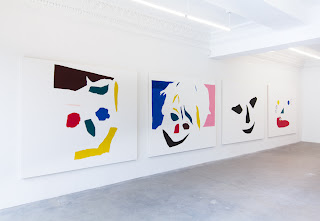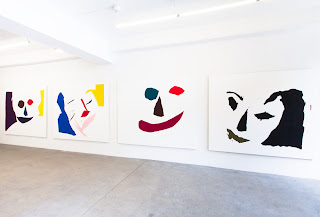Caught within the barrage of
historical and contemporary images, Andrew Gbur’s recent paintings and Eleven
Rivington creates a pathological relationship with images that renders the
artist and the viewer spellbound but in dark isolation. At the Rivington
location, Gbur covers the walls with three large-scale paintings that are
striking but will shake the viewer for their sporadic selection of imagery. The
backgrounds consist of grids or stripes, patterns extracted from modernist
vernacular of geometric abstraction, silkscreened in bright colors of red,
yellow, or green. Overlaying those patterns are collages of pop images of faces,
lights, alters, batteries, or clothes that, when composed in symmetrical orientation, invite the viewer to explore the cryptic language that
Gbur provides for his paintings. The patterns and images become a
powerful alter-like composition similar to medieval paintings but put into
contemporaneous context for the use of pattern and images, uncanny to the viewer. The images are recognizable
from life but can only be understood as a formal grouping. Placement and form,
more than symbolic content, creates the context of the fantasy world created in
the geometrically open, but chromatically and imaginarily assaulting,
paintings. What these paintings present is an architectural formation of the
uncanny- the nonsense of everything that should make sense (recognizable images and orderly pattern).
At the Chrystie street location, Gbur
continues with this project with eight renderings of smiling faces generalized by
isolating specific aspects of the face- hair, eyes, nose, and mouth- into
specific shapes of bright and assaulting colors. The faces are larger than life, confronting the viewer like
sidewalk advertisements confront a walking pedestrian. However these patches of color have a torn paper quality, as if rendered by a child. The faces stare out of the
painting, not necessarily at the viewer, and into empty space. This
emptiness and child-like play gives the warmth of a smile a precarious
makeover, providing a haunting after-taste for their dominating but enigmatic
presence.













